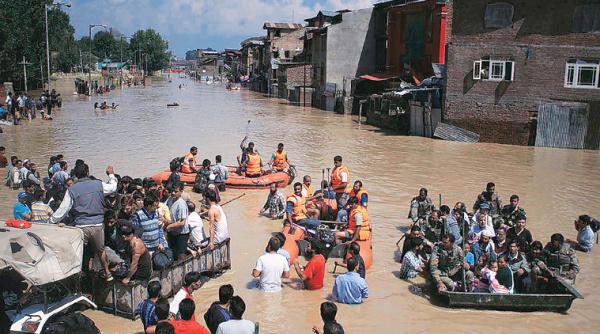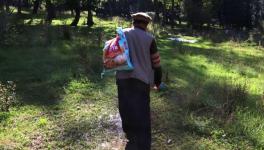Kashmir Floods Punctures Tall Claims of Irrigation Department, Locals Furious

Incessant and heavy rains lashed the valley on July 1. With rising water levels in Jhelum, the residents of Kashmir were reminded of the devastating floods that transpired in 2014. Panicking through the day, the locals kept a tab on the rising levels of Jhelum water, with local media portals updating them with the information. A notification flash conveying that Jhelum has crossed the “danger mark” caused terror in the entire valley, with residents living in the low-lying areas moving their valuables to upper floors and moving to areas where the dangers of flooding were lesser.
Streets were water logged in most areas. The news that two people had drowned in the Valley, and that three lives were lost in the Jammu region aided the fear. The rain let up by the evening, alleviating the anxiety of the locals, but not completely erasing perpetual fear that floods might hit the valley, yet again. At least 280 lives were claimed in the 2014 floods with additional property damage worth crores. Meanwhile, the local weather department has warned of the possibility of “incessant rain” in the upcoming days.
Also Read: Thousands Lose Jobs, Wages As Restive Kashmir’s Tourism Economy Dwindles
“We have only one question to ask. What has the government been doing after 2014 floods? PDP, along with the Centre, made big promises to prevent the flood with huge packages. Where has all the money gone? We know the government wants people to die either from the flood, else by the guns. How corrupt are these politicians?” asked Yonus, a local resident from Karan Nagar, Srinagar. As the locals are accusing politicians, opposition party leader Omar Abdullah didn’t miss the chance to take a dig at the PDP-BJP alliance on Twitter. “What was the PDP-BJP government doing after the devastating floods of 2014? What happened to the dredging of the Jhelum? Why was the carrying capacity of the flood channel not increased? Where did the money go?” He wrote.
Jhelum dredging: Not the only solution
When the water in Jhelum surged and crossed the danger marks, by crossing 33 feet in Anantnag, South Kashmir and 23 feet in Ram Bagh, Srinagar in 2014, the government had announced a Rs 46 crore dredging project to be executed by a Kolkata-based firm, Reach Dredging Limited, in a joint venture with a China firm, Hubei Hongyan Engineering Company Limited.
However, allegations have been made against Reach Dredging Limited “We have been observing that they have extracted sand from Jhelum and using it for commercial purpose. This has led to weakening of embankments. Governor has taken a serious cognisance of the mishandling by the irrigation department regarding the money spent by them, and we are closely monitoring the matter,” environmental advocate and convener of Enivronmental Policy Group, Nadeem Qadri told Newsclick.
After the 2014 floods, Jammu and Kashmir government had submitted a proposal seeking Rs 44,000 crore from the central government for building flood management infrastructure, and rehabilitation of victims. Modi government had sanctioned only a Rs 8,000-crore flood relief package for Jammu and Kashmir. In addition to that, The World Bank had also allotted Rs 1,580 crore for flood relief in 2015.
A group of concerned citizens including journalists and activists have appealed to Governor N. N. Vohra to order a CBI probe into “Jhelum dredging”. Commentators believe that Jhelum water dredging was a 46 crore scam which, in the name of development, filled pockets of the politicians and others at the helm of affairs.
According to Mohammad Aslam, executive engineer of the Irrigation and Flood Control Department, dredging is not the only solution. “Dredging is not the only component. It is 10 per cent of the entire flood management project. People are pre-occupied with the idea that dredging will make difference but that is not the case. However, we have succeeded in the dredging, 93 per cent of dredging has been done in Srinagar and 81 per cent in Baramulla. The dredging contract was over on March 31, 2018.”
The commentators have dismissed the claims made by the department. “The dredging work should start from downstream, but they started from upstream. If you started from upstream then, where will the water go? This is the basic question,” said Shafiq Pandit, retired KAS officer.
“If the dredging was done scientifically, this would not have happened. But the dredging was not done according to the plan, and result is in front of us. Dredging might occupy less percentage, but it has an important part to play,” said Rhomsoo Shakeel, a scientist from Kashmir University.
“Dredging should not be a one-time affair, it has to be done annually. In 2014, because of floods, a lot of slit was accumulated, so dredging has to be an annual affair. Traditionally, Kashmir is prone to floods; it’s not a new thing. On the both sides of Jhelum, there were flood plains, whenever there was flooding, the flood plains used to play their part. But then, the flood plains were converted into housing colonies, which is also one of the reasons,” added Shakeel.
Flood management plans
The officials of Irrigation and Flood Control department have maintained that they had invited for tenders for this flood management project. Based on efficiency and budget, Reach Dredging Limited was finalised. “We have been doing our job efficiently. The total cost of the Flood Management (FM) project was 399.29 crores. 142.33 crores were used for land compensation of FSC at Shariefabad and Naidkhai. 35.29 crores have been used for the construction of two bridges on FSC, at Shariefabad and Naidkhai. 82 crores have been used for re-sectioning of FSC. 46 crores have been used for the dredging of river Jhelum in various stretches, out of which, 20 crores were spent in Srinagar, and another 26 in Baramulla. 73 crores were spent on flood protection works on river Jhelum at vulnerable spots from Khananbal to Baramulla, including city channels, that is, Sonar Kul and Kuttkul. Remaining 20.67 crores were spent on other project sub heads,” said Shahnawaz Mir, Chief Engineer of Irrigation and Flood Control Department.
“Events like killing of Burhan Wani, which led to unrest in the valley, and cloud bursts and harsh winter in 2016-17 have halted our work. These are the natural factors, we can’t do anything about them,” said Mir.
“We don’t believe these figures. Previously, flood alerts used to be raised after one week of incessant rainfall. This time the flood alert came within 40 hours of rainfall. You can easily see the work they have done,” said a local resident on the condition of anonymity.
Where has the money gone?
“The purpose of dredging is to extract not only sand, but also silt and clay. After dredging, there has to be a dike where they will dump this sand. Around Srinagar, there is such no dike where they dumped they dumped the sand for further lifting. They only extracted sand from Jhelum, and so the dredging was of no use. In fact, this caused weakening of embankments,” said Environmental advocate and convener of Environmental Policy Group, Nadeem Qadri.
“Now that the matter has been taken up by the Governor himself, he has ordered a probe and investigation into matter. We are hopeful that we will find out where has all the money been used,” added Qadri.
Get the latest reports & analysis with people's perspective on Protests, movements & deep analytical videos, discussions of the current affairs in your Telegram app. Subscribe to NewsClick's Telegram channel & get Real-Time updates on stories, as they get published on our website.
























